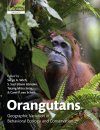![Orangutans: Geographic Variation in Behavioral Ecology and Conservation Orangutans: Geographic Variation in Behavioral Ecology and Conservation]()
Click to have a closer look
About this book
Contents
Customer reviews
Related titles
About this book
This book describes one of our closest relatives, the orangutan, and the only extant great ape in Asia. It is increasingly clear that orangutan populations show extensive variation in behavioural ecology, morphology, life history, and genes. Indeed, on the strength of the latest genetic and morphological evidence, it has been proposed that orangutans actually constitute two species which diverged more than a million years ago - one on the island of Sumatra the other on Borneo, with the latter comprising three subspecies.
This book has two main aims. The first is to carefully compare data from every orangutan research site, examining the differences and similarities between orangutan species, subspecies and populations. The second is to develop a theoretical framework in which these differences and similarities can be explained. To achieve these goals the editors have assembled the world's leading orangutan experts to rigorously synthesize and compare the data, quantify the similarities or differences, and seek to explain them.
Orangutans is the first synthesis of orangutan biology to adopt this novel, comparative approach. It analyses and compares the latest data, developing a theoretical framework to explain morphological, life history, and behavioural variation. Intriguingly, not all behavioural differences can be attributed to ecological variation between and within the two islands; relative rates of social learning also appear to have been influential. The book also emphasizes the crucial impact of human settlement on orangutans and looks ahead to the future prospects for the survival of critically endangered natural populations.
Contents
Introduction; 1. Taxonomy, geographic variation and population genetics of Bornean and Sumatran orangutans; 2. The functional significance of variation in jaw form in orangutans: The African apes as an ecogeographic model; 3. Orangutan positional behavior: inter-specific variation and ecological correlates; 4. A description of the orangutan's vocal and sound repertoire, with a focus on geographic variation; 5. Orangutan life history variation; 6. Orangutan distribution, density, abundance and impacts of disturbance; 7. The effects of forest phenology and floristics on populations of Bornean and Sumatran orangutans: are Sumatran forests better orangutan habitat than Bornean forests?; 8. Orangutan activity budgets and diet: A comparison between species, populations and habitats; 9. Geographic variation in orangutan diets; 10. Parasites and their impacts on orangutan health; 11. The ecology of female reproduction in wild orangutans; 12. Development of independence: Sumatran and Bornean orangutans compared; 13. Ranging behavior of orangutan females and social organization; 14. Geographical variation in orangutan long calls; 15. Male-male relationships in orangutans; 16. Orangutan mating behavior and strategies; 17. Social organization and male-female relationships; 18. Ecological sex differences in wild orangutans; 19. Nest building in orangutans; 20. Innovation and intelligence in orangutans; 21. Orangutan cultures revisited; 22. Orangutan population biology, life history, and conservation: Perspectives from PVA models; 23. Orangutan rehabilitation and reintroduction: Successes, failures, and role in conservation; 24. Geographic variation in orangutan behavior and biology: its functional interpretation and its mechanistic basis; References; Index
Customer Reviews



















![Atlas des Mammifères Sauvages de France, Volume 3: Carnivores et Primates [Atlas of Wild Mammals of France, Volume 3: Carnivores and Primates]](http://mediacdn.nhbs.com/jackets/jackets_resizer_medium/26/263780.jpg?height=150&width=106)
















